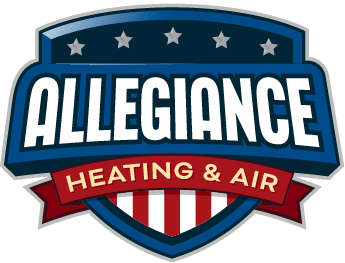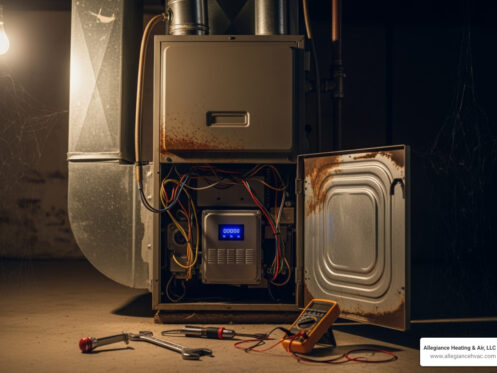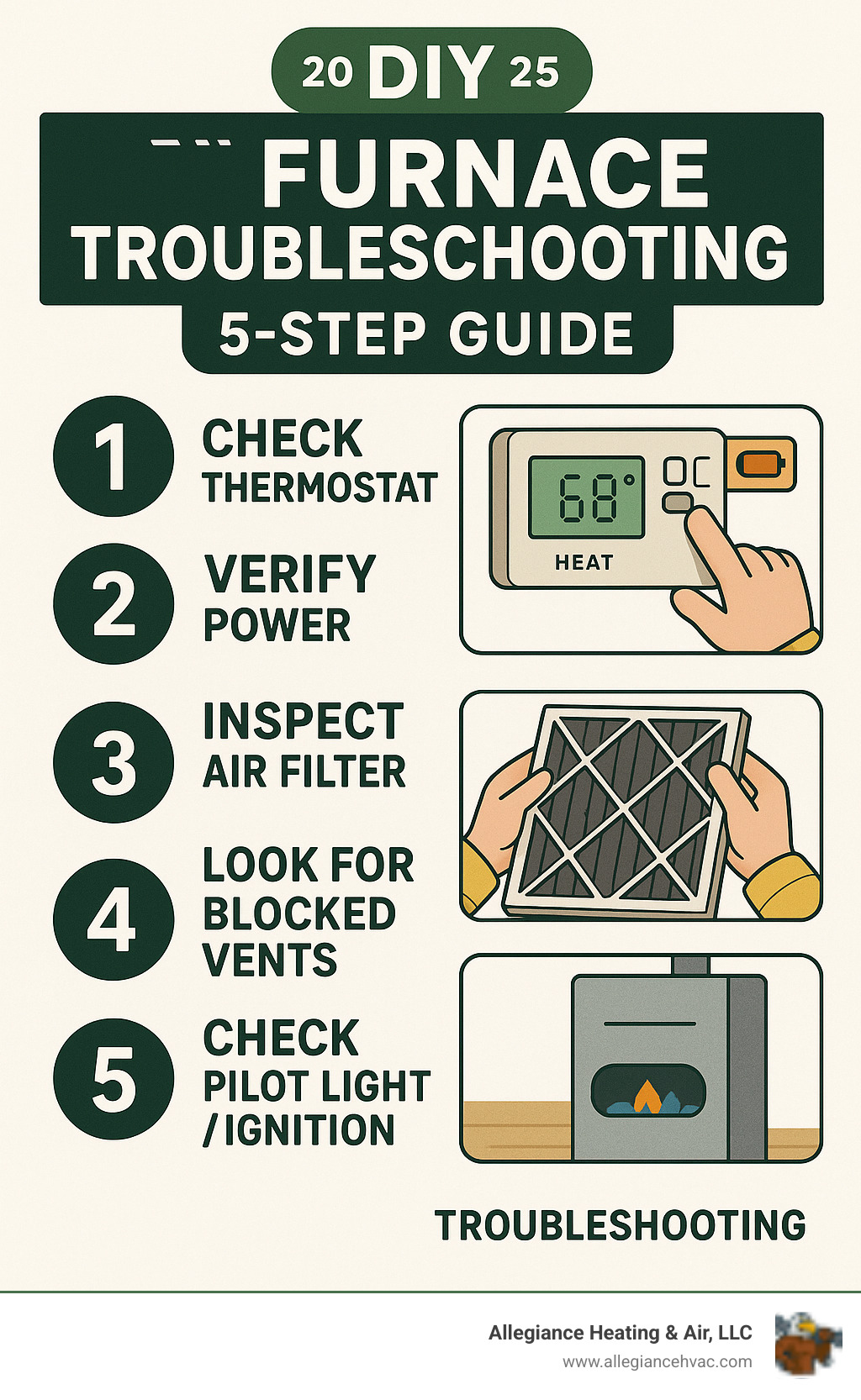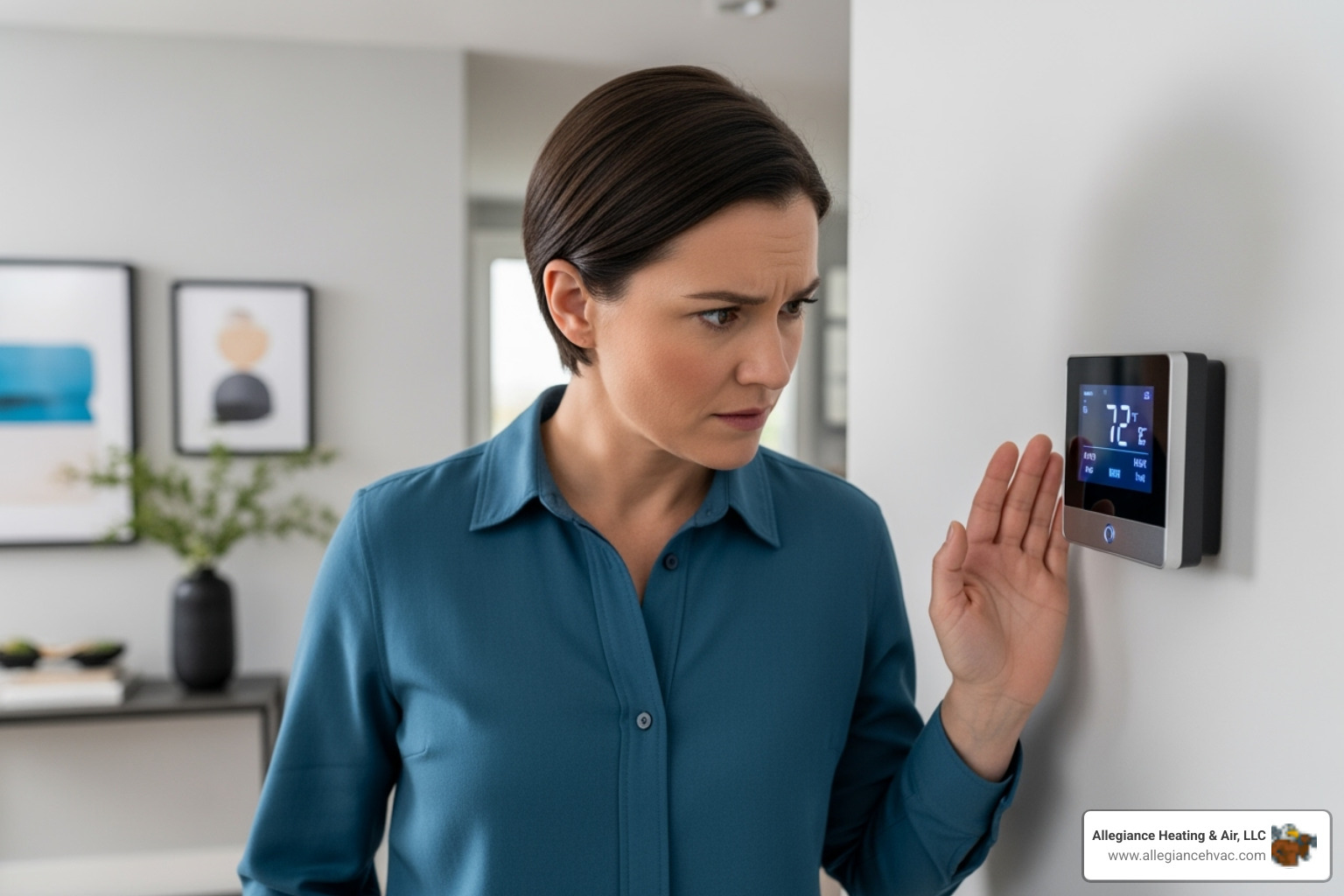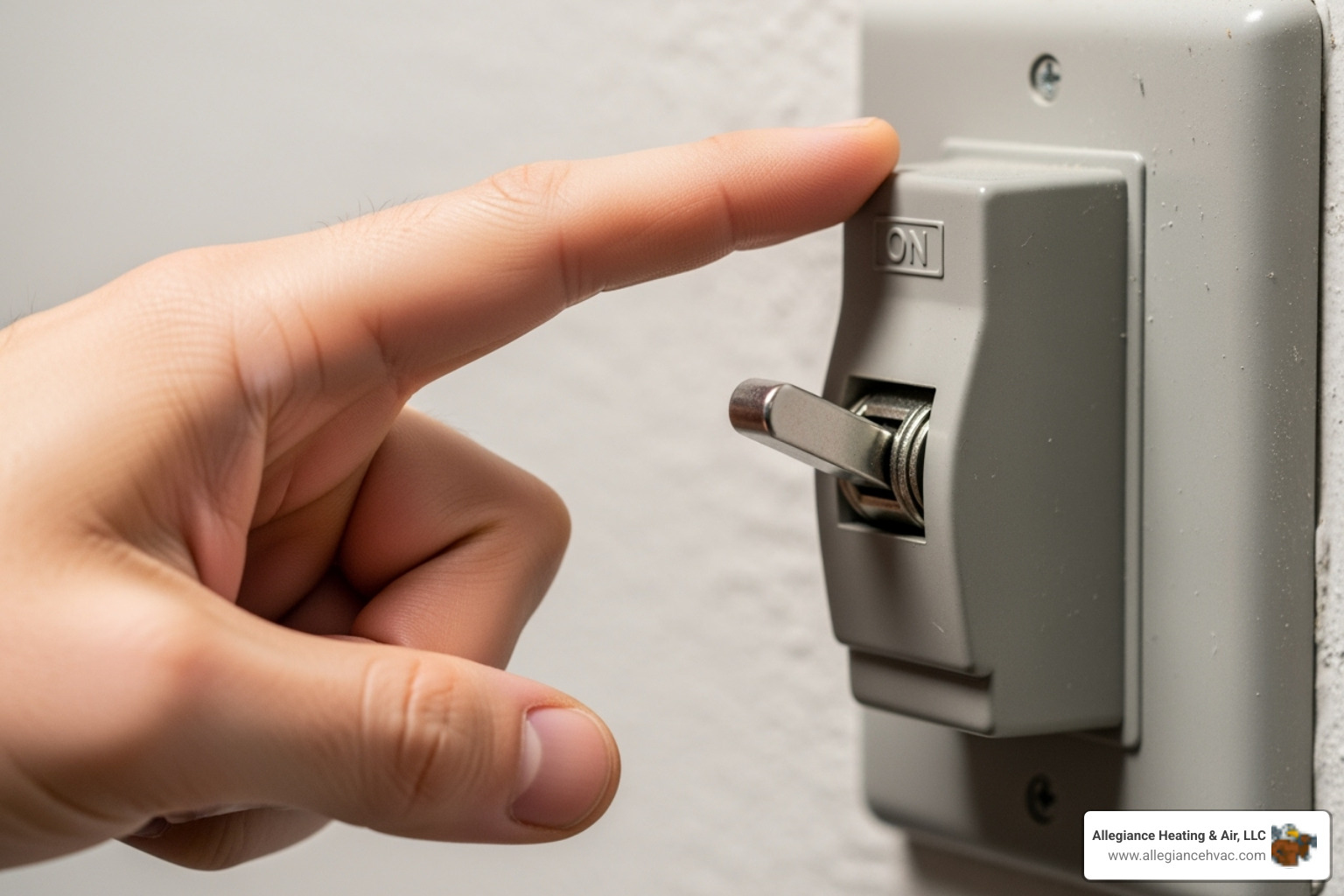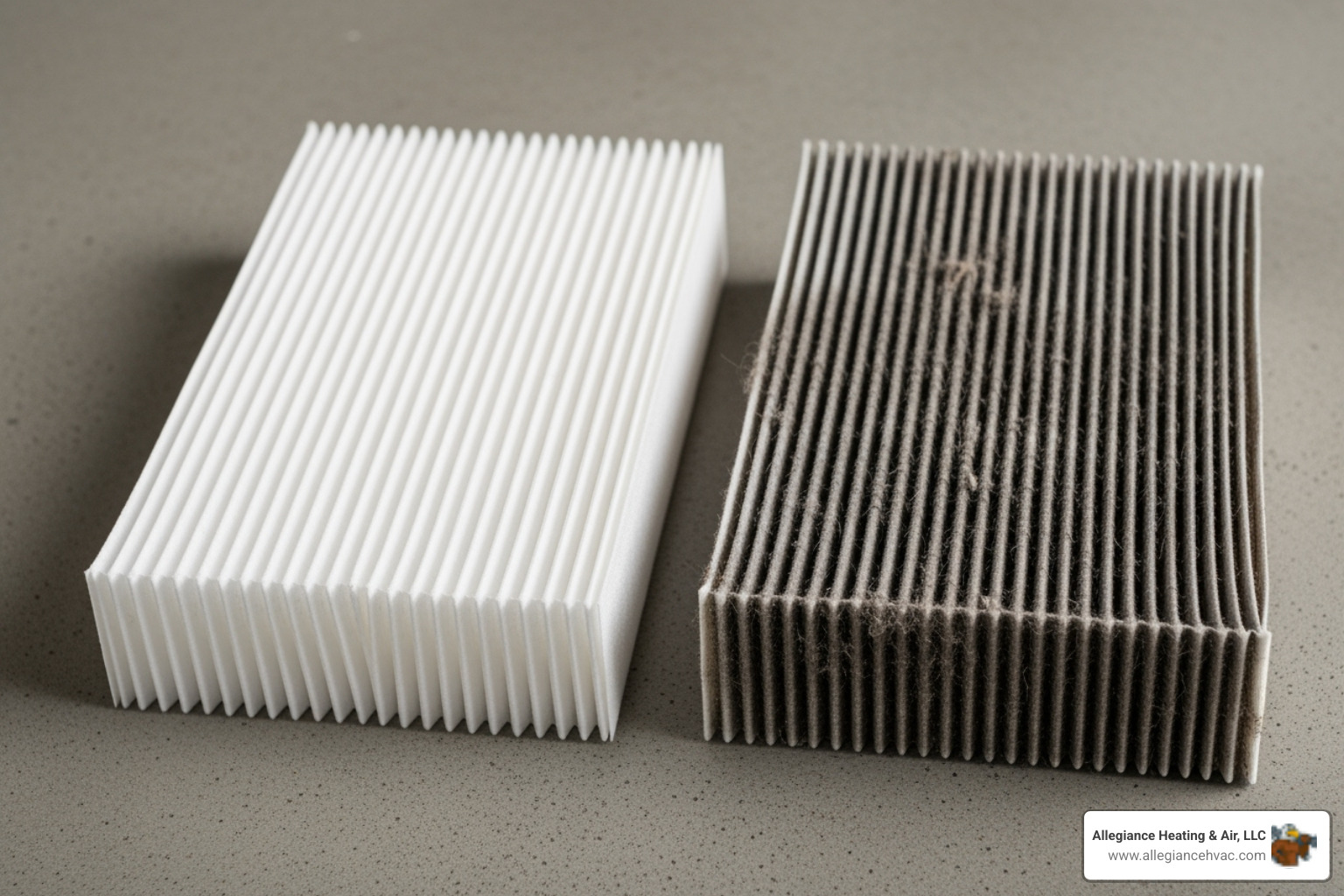When Your Furnace Stops Working: Quick Steps Before You Call for Help
When your furnace not working leaves you shivering in your own home, don’t panic. Most furnace problems have simple causes that you can check yourself before calling a technician.
Quick Furnace Troubleshooting Checklist:
- Check your thermostat – Make sure it’s set to “Heat” and the temperature is higher than your room temperature
- Replace dead batteries – Many thermostat issues are just dead batteries
- Verify power supply – Check that your furnace switch is “ON” and the circuit breaker hasn’t tripped
- Inspect your air filter – A dirty filter can shut down your entire system
- Look for blocked vents – Make sure nothing is blocking your heating vents or air returns
You’re wearing your thickest socks and wrapped in a blanket, but there’s still an unmistakable chill in the air. The frustrating part? You’re not outside – you’re standing in your living room because your furnace has decided to take an unscheduled break.
Before you start dialing HVAC companies and worrying about repair bills, take a deep breath. Many furnace problems are surprisingly simple to fix. In fact, HVAC technicians report that a significant portion of their “emergency” calls turn out to be basic issues like incorrect thermostat settings or tripped circuit breakers.
This guide will walk you through the most common reasons your furnace stops working and show you exactly what to check. Some fixes take just minutes and could save you both time and money. However, we’ll also help you recognize when it’s time to step back and call in the professionals – especially when safety is a concern.
Start with the Simple Stuff: 3 Easy Checks for Your Furnace
When your home feels more like an igloo than a cozy retreat, it’s natural to assume the worst. But here’s some good news: most furnace problems start with surprisingly simple causes. Before you start imagining expensive repairs, let’s walk through three basic checks that could have your heat humming again in just a few minutes.
These troubleshooting steps are completely safe for homeowners and don’t require any special tools. Think of this as your first line of defense against the cold!
Thermostat Glitches: A Common Reason Your Furnace is Not Working
Your thermostat might be small, but it’s the boss of your entire heating system. When it’s not doing its job properly, your furnace not working could be the result of a simple communication breakdown.
Start with the basics: make sure your thermostat is set to “Heat” mode. It sounds almost too simple, but you’d be amazed how often someone accidentally switches it to “Cool” or “Off” while dusting or adjusting the temperature. Next, check that your temperature setting is at least 5 degrees higher than what your home currently feels like.
Dead batteries are thermostat enemy number one. If your display looks blank or dim, pop in some fresh batteries. Even thermostats that are hardwired into your home’s electrical system often rely on batteries as backup power. We recommend swapping them out once a year – maybe when you change your smoke detector batteries.
Got a programmable or smart thermostat? These helpful devices can sometimes outsmart themselves. Double-check your programmed schedule to make sure it’s not set to keep things chilly during the hours you want warmth. Smart thermostats occasionally need a gentle reset to clear up any digital hiccups.
Here’s something many people don’t consider: where your thermostat lives matters. If it’s getting confused by a nearby lamp, sunny window, or drafty door, it might think your home is warmer or cooler than it actually is. This can cause your furnace to act unpredictably or not turn on when you need it most.
Verify the Furnace Has Power
Sometimes the most obvious solution is the right one. Your furnace is basically a sophisticated electrical appliance, and like any appliance, it needs power to work its magic.
Hunt down your furnace’s power switch first. This usually looks like a regular light switch and sits on or near your furnace unit, sometimes mounted on the wall nearby. Make sure it’s flipped to “ON.” You might chuckle, but this switch gets accidentally turned off more often than you’d think – especially during cleaning sessions or when curious kids are exploring.
Next stop: your home’s electrical panel. Look for the circuit breaker labeled for your furnace or HVAC system. If it’s tripped, you’ll typically see it sitting in the middle position or flipped to “OFF.” Here’s how to reset it properly: push it firmly all the way to “OFF” first, then flip it back to “ON.” Give your system a few minutes to wake up before checking if your furnace is working again.
If that breaker keeps tripping, stop and call for help. Repeatedly tripped breakers usually signal a more serious electrical issue that needs professional attention. This isn’t the time for DIY heroics – electrical problems can be dangerous.
The Dirty Air Filter Dilemma
Picture trying to breathe through a thick, dusty sock. That’s exactly what your furnace deals with when its air filter is clogged with months of dust, pet hair, and household debris.
A dirty filter is like kryptonite to your heating system. Your furnace needs steady airflow to operate safely and efficiently. When that filter gets packed with grime, it creates a bottleneck that forces your system to work much harder than it should.
Here’s where things get serious: a severely clogged filter can cause your furnace’s heat exchanger to overheat. When this happens, a safety device called the high-limit switch steps in and shuts everything down to prevent damage. The result? Your furnace not working at all, or blowing nothing but cold air.
The fantastic news is that changing your filter takes about two minutes and costs just a few dollars. Most homes need a fresh filter every three months, though homes with pets, smokers, or family members with allergies might need monthly changes. Check your filter regularly – if you can’t see light through it when you hold it up, it’s time for a replacement.
Never run your furnace without a filter – even temporarily. Without this protection, dust and debris can damage expensive internal components like your blower motor. Modern furnaces are more efficient than older models, but they still depend on clean filters to do their best work.
Why Is My Furnace Not Working? Deeper Troubleshooting Steps
So you’ve tackled the basics—checked your thermostat, confirmed the power is on, and swapped out that dusty air filter—but your furnace not working is still leaving you bundled up like you’re camping in the Arctic. Time to roll up your sleeves and investigate some of the more complex furnace components that might be causing the trouble.
Before we dive deeper into your furnace’s inner workings, there’s one crucial step: always turn off the power to your unit at both the furnace switch and the circuit breaker. We can’t stress this enough—safety first! Whether you have a gas furnace or electric furnace, these components can be tricky, and we want you warm, not hurt.
Pilot Light or Electronic Igniter Issues
If your furnace is older, it likely has a standing pilot light—think of it as the tiny eternal flame that’s supposed to spring your main burners into action. When this little flame decides to take a vacation, your furnace won’t produce any heat. It’s like trying to light birthday candles without a lighter.
Common reasons your pilot light goes out include drafts sneaking into your furnace area, a dirty pilot opening that’s gotten clogged with debris, or a faulty thermocouple. The thermocouple is your furnace’s safety guardian—it senses when the pilot flame is burning and cuts off the gas supply if that flame disappears, preventing dangerous gas leaks.
If you’ve tried relighting your pilot light following the instructions on your furnace (usually found on a label inside the furnace door) and it won’t stay lit, you’re likely dealing with a thermocouple that’s given up the ghost.
Newer furnaces have moved beyond the pilot light era and use electronic igniter systems instead. These modern marvels heat up quickly to ignite the gas or create a spark to get things going. If your furnace makes clicking sounds but never actually fires up, the problem might be with the electronic igniter or the flame sensor.
The flame sensor is a small rod that acts like a watchful sentinel, confirming that a flame is actually present. Over time, this sensor can get dirty and lose its ability to “see” the flame. When that happens, your furnace shuts down as a safety precaution. The good news? Cleaning a dirty flame sensor with fine steel wool or sandpaper often solves this frustrating issue.
Blocked Vents and Air Ducts
Your furnace might be working perfectly, cranking out heat like a champ, but if that warm air can’t reach your living spaces, you’ll still feel like you’re living in an igloo. Blocked vents and obstructed ductwork are sneaky culprits that often lead to uneven heating—some rooms toasty, others feeling like walk-in freezers.
Start your detective work by taking a tour of your home. Check all your supply vents (where the warm air flows out) and return air grilles (where cool air gets sucked back into the system). Make sure they’re fully open and not playing hide-and-seek behind furniture, rugs, curtains, or that pile of laundry you’ve been meaning to fold. We’ve seen everything from overzealous pet beds to misplaced storage boxes turning cozy homes into arctic zones.
Sometimes the trouble lies deeper in your ductwork system. Dampers—adjustable plates inside the ducts—might be closed, choking off airflow to certain rooms. Less commonly, you might find debris or even enterprising animals that have decided your ducts make excellent real estate.
If you notice significant cold spots or weak airflow from specific vents, it’s worth investigating your accessible ductwork. Look for leaks or gaps where your heated air might be escaping into crawl spaces or basements instead of warming your living areas. Sealing duct leaks with proper metal duct tape can dramatically improve both airflow and heating efficiency.
High-Efficiency Furnace Drain Line Problems
If you’re the proud owner of a high-efficiency condensing furnace, you might encounter a problem that older furnaces never deal with: condensate drain line issues. These modern furnaces are incredibly efficient, but they produce water as a byproduct of their heating magic.
High-efficiency furnaces create condensation during operation, and this water needs somewhere to go. It collects in a drain pan and travels out of your home through a PVC pipe, often helped along by a condensate pump. Think of it like your furnace’s personal plumbing system.
When this drain line gets clogged with algae, debris, or other gunk, water starts backing up like a sink with a hairball problem. Most high-efficiency furnaces have a built-in safety feature called an overflow kill switch that automatically shuts down the furnace when it detects water accumulation. It’s like having a smoke detector, but for water damage.
If you spot water pooling around your furnace base, a clogged condensate line is likely the troublemaker. Often, you can resolve this by flushing the line with a bleach-and-water solution to clear out the blockage and get your furnace humming again.
When to Stop and Call a Professional
We’ve covered a lot of ground in helping you troubleshoot your furnace not working situation. While we believe in empowering homeowners to handle basic checks, there comes a point where it’s time to step back and let the professionals take over. Your safety is always the most important consideration.
Some furnace problems are simply beyond what any homeowner should attempt. Complex electrical issues, gas-related problems, or mechanical failures require specialized training and tools. More importantly, certain warning signs indicate potentially dangerous situations that need immediate professional attention.
At Allegiance Heating & Air, LLC, we’ve been serving families in Southern Indiana and Kentucky since 2005. We understand that furnace problems never happen at convenient times, and we’re here to help when your DIY efforts have reached their limit.
Safety First: Critical Warning Signs
There are certain situations where you should immediately stop troubleshooting and call for professional help. These warning signs indicate potential safety hazards that could put you and your family at risk.
The smell of gas is the most serious warning sign. If you detect that distinctive rotten egg odor anywhere in your home, don’t try to fix anything yourself. Leave your home immediately, call 911, and contact your gas company. Avoid turning any lights or appliances on or off, as even a small spark could be dangerous.
Loud banging or scraping noises from your furnace are another red flag. While some operational sounds are normal, violent banging, grinding, or scraping usually means something mechanical has failed or is about to fail. This could be a failing blower motor, loose components, or even a cracked heat exchanger.
A yellow pilot flame instead of a steady blue one indicates incomplete combustion. This can produce carbon monoxide, a colorless and odorless gas that’s extremely dangerous. Similarly, a cracked heat exchanger can allow carbon monoxide to leak into your home’s air supply. If you suspect either of these issues, evacuate your home and call for professional help immediately.
Make sure your home has working carbon monoxide detectors on every level. They’re your early warning system for this silent threat.
What to Do When Your Furnace is Not Working After All Checks
Sometimes, despite your best troubleshooting efforts, your furnace continues to give you trouble. Persistent issues or intermittent problems that come and go can be particularly frustrating because they’re often caused by failing components that haven’t completely broken yet.
Electrical component failures like a malfunctioning control board, faulty transformer, or failing blower motor require diagnostic equipment and expertise that most homeowners don’t have. These components control critical furnace functions, and replacing them incorrectly can create safety hazards or damage other parts of your system.
Intermittent problems are especially tricky because they might seem to fix themselves, only to return when you least expect it. These issues often indicate components that are on their way out but haven’t failed completely yet.
When you’ve exhausted the safe troubleshooting options we’ve outlined, it’s time to call in a NATE-certified HVAC technician. Our experienced team at Allegiance Heating & Air, LLC has the training and tools to diagnose complex problems safely and efficiently.
We serve Greenville, IN, Louisville, KY, and the surrounding areas including Floyd County, Clarksville, Sellersburg, Jeffersonville, and Floyds Knobs. As a family-owned business, we understand how important your home’s comfort is to your family’s well-being. Our highly vetted technicians will get to the bottom of your furnace problems and restore your heat safely and efficiently.
Frequently Asked Questions about Furnace Problems
When your heating system starts acting up, you’re probably not the first person to wonder what’s going wrong. We’ve been helping families across Southern Indiana and Kentucky since 2005, and these are some of the most common questions we hear when someone calls us about their furnace not working.
Why does my furnace turn on and off constantly?
Nothing’s more annoying than hearing your furnace kick on, run for a few minutes, then shut off again – only to repeat this cycle all day long. This frustrating pattern is called “short cycling,” and it’s not just inefficient; it can actually wear out your furnace components much faster than normal.
The most likely culprit? That clogged air filter we talked about earlier. When your filter is packed with dust and debris, it restricts airflow so much that your furnace overheats quickly. The safety switch kicks in, shuts everything down, and then the whole cycle starts over again once things cool down.
Sometimes the problem is that your furnace is too big for your home. An oversized unit heats your space so quickly that it reaches the thermostat setting and shuts off, only to turn back on when the temperature drops slightly. It’s like having a race car in a school zone – too much power for the job.
Check your thermostat’s location too. If it’s sitting next to a sunny window or near a heat-producing appliance, it might think your home is warmer than it really is. This tricks your furnace into short cycling because the thermostat is getting false temperature readings.
Other issues like a blocked flue or a faulty limit switch can also cause your furnace to overheat and trigger its safety shutdown. If changing your air filter doesn’t solve the short cycling, it’s time to call us for a proper diagnosis.
Why is my furnace running but blowing cold air?
This scenario is particularly maddening – you can hear your furnace humming away, but instead of cozy warmth, you’re getting a blast of cold air. Before you panic, check your thermostat’s fan setting. If it’s set to “ON” instead of “AUTO,” your fan will run continuously, circulating unheated air throughout your home even when the heating cycle isn’t active.
For gas furnaces, the issue might be an extinguished pilot light or a problem with the electronic igniter. The fan can still run even if the burners aren’t firing up, which means you’ll get air movement without any heat. Similarly, if there’s a gas supply issue – maybe the gas valve got turned off accidentally or there’s a broader supply problem in your area – the burners won’t light but the fan will keep doing its job.
High-efficiency furnaces have their own unique challenge: a clogged condensate drain line. When this happens, a safety switch prevents the burners from igniting while the fan continues to operate, resulting in cold air circulation.
Sometimes your furnace has overheated and shut down the heating elements due to airflow problems, but the fan keeps running to help cool things down. This often happens after the furnace has been struggling with a dirty filter or other airflow restrictions.
What should I do if my furnace’s circuit breaker keeps tripping?
Resetting a tripped circuit breaker once is fine – these things happen. But if your furnace breaker keeps tripping repeatedly, that’s your electrical system waving a big red flag that something’s seriously wrong.
A breaker that won’t stay reset usually means there’s an electrical short somewhere in your furnace’s wiring or components. This could be caused by damaged wires, moisture getting into electrical connections, or a component that’s failing and drawing too much power.
Your circuit might also be overloaded, especially if a specific component like the blower motor is malfunctioning and pulling excessive current. Sometimes age catches up with electrical components, and they start demanding more power than they should.
Here’s the important part: a circuit breaker that keeps tripping isn’t just an inconvenience – it’s a potential fire hazard. Please don’t keep resetting it hoping the problem will magically fix itself. Each time it trips, your electrical system is protecting your home from a dangerous situation.
When you’re dealing with persistent electrical issues, it’s definitely time to step back and let our experienced technicians handle the diagnosis and repair safely. We have the tools and expertise to identify exactly what’s causing the problem and fix it properly the first time.
Get Your Heat Back On and Stay Warm
When your furnace not working leaves you bundled up in blankets inside your own home, it’s frustrating and uncomfortable. But now you’re armed with knowledge! We’ve walked through the most common culprits behind furnace problems, from simple thermostat glitches and power issues to dirty air filters and blocked vents.
Many furnace issues really do have straightforward solutions that you can handle yourself. Checking your thermostat settings, replacing dead batteries, resetting a tripped circuit breaker, or swapping out a clogged air filter can often get your heat flowing again in just minutes. These simple fixes can save you both time and money while keeping your family comfortable.
Remember though, safety always comes first. If you smell gas, hear concerning noises like loud banging or scraping, or notice a yellow pilot flame, don’t hesitate – call for professional help immediately. These are serious warning signs that require expert attention.
At Allegiance Heating & Air, LLC, we’ve been keeping families warm and comfortable in Greenville, IN, Louisville, KY, and throughout Southern Indiana and Kentucky since 2005. As a family-owned business, we understand how important your home’s comfort is to you and your loved ones. Our highly vetted technicians are ready to help when DIY troubleshooting isn’t enough or when safety concerns arise.
Whether you need a quick repair or it’s time to consider a more comprehensive solution, we’re here with trusted, customer-first service. Sometimes an aging furnace that’s constantly breaking down is telling you it’s ready for retirement.
Don’t let another cold night catch you off guard. Schedule your furnace replacement in Louisville, KY and ensure reliable warmth for years to come.

